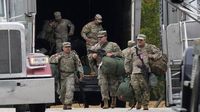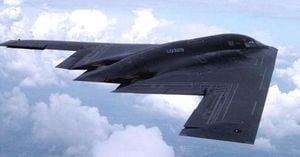In a whirlwind week for the Texas National Guard and the U.S. military at large, a viral photo, a rapid deployment, and a fierce debate about fitness standards have thrust America’s armed forces into the national spotlight. The controversy began on October 7, 2025, when an Associated Press photo showing Texas National Guard troops arriving outside Chicago, Illinois, quickly made the rounds online. The image’s unexpected focus: several soldiers with rounded stomachs, thick necks, and chubby faces—an appearance that sparked a firestorm of commentary and official action.
The deployment itself was significant. According to TNND, 200 Texas National Guard troops were sent to Chicago as part of President Donald Trump’s federalization of the city, a move intended to bolster security around federal facilities and address ongoing unrest. But the attention soon shifted from the mission’s purpose to the physical condition of some of its participants. Social media lit up with jokes and criticism, with one commenter quipping, “Texas National Guard arrives in Chicago... for the food I assume.”
The reaction from military leadership was swift and uncompromising. As reported by multiple outlets, including Daily Mail and Task & Purpose, Defense Secretary Pete Hegseth—often referred to in the press as the Secretary of War—responded to the viral photo and ensuing debate with a blunt message. On October 13, 2025, Hegseth posted on X (formerly Twitter), “Standards are back at The @DeptofWar,” sharing a link to a story about the replacement of some Texas National Guard troops in Illinois after they failed to meet fitness standards.
Behind the scenes, the Texas Military Department was already conducting a “validation process” to ensure all mobilized troops met service-specific height, weight, and physical fitness requirements. “In less than 24 hours, Texas National Guardsmen mobilized for the Federal Protection Mission,” a department spokesperson told Task & Purpose. “The speed of the response necessitated a concurrent validation process, during which we identified a small group of service members who were not in compliance and have been replaced.”
The department’s official statement, released on October 9, 2025, left little room for ambiguity: “National Guard Soldiers and Airmen are required to meet service-specific height, weight and physical fitness standards at all times. When mobilizing for active duty, members go through a validation process to ensure they meet those requirements. On the rare occasions when members are found not in compliance, they will not go on mission. They will be returned to their home station, and replacements who do meet standards will take their places.”
Yet, even with these clear statements, questions lingered. As the Daily Mail pointed out, the Department of War has not released detailed guidance on what exactly constitutes failure in terms of height, BMI, or body fat percentage. For example, Army standards specify that a male soldier aged 17 to 20 who is 5'10" can weigh no more than 178 pounds. If that threshold is exceeded, a body fat percentage calculation—factoring in abdominal circumference—determines eligibility. If a soldier fails both, they can request a body fat assessment via advanced tools like the DXA, InBody 770, or The Bod Pod. Ultimately, those who fail all evaluations are referred to the army weight control program. Still, the precise failure thresholds remain somewhat opaque, leaving some service members and observers frustrated.
Secretary Hegseth has made his position unmistakably clear. Speaking at a summit of military leaders at Marine Corps Base Quantico in late September, he declared, “I’m tired of seeing fat troops.” He doubled down on the need for rigorous standards, stating that troops will now be required to do physical fitness every day and undergo twice-yearly fitness testing. “If the Secretary of War can do regular, hard PT, so can every member of our joint force,” Hegseth asserted, as quoted in the Daily Mail. He emphasized that these new rules are “not about preventing women from serving,” but insisted that the standards needed to be gender-neutral. “If women can make it, excellent, if they cannot — then so be it ... it will also mean that weak men won’t qualify. This is combat.”
Hegseth’s rhetoric has not gone unchallenged. A Pentagon spokesman, speaking to the Daily Mail, highlighted that height and weight requirements depend on the service branch and pointed to the Army’s body fat calculator, introduced in 2023. Meanwhile, an anonymous military member voiced a different perspective: “I have two degrees, which should mean more than my exact specifications and exactly how far I can run,” they told the Daily Mail, adding a blunt assessment of Hegseth’s priorities. The comment underscores a broader debate about the balance between physical readiness and other essential military skills in a modern, technologically advanced force.
Amid the uproar, the Texas Military Department declined to provide additional context about which troops were removed or how they specifically failed to meet standards. It also remains unconfirmed whether any of the soldiers pictured in the now-infamous AP photo were among those replaced. What is clear is that the episode has reignited a national conversation about military fitness, readiness, and the image the armed forces project to the public.
Complicating matters further, legal challenges have emerged regarding the deployment itself. As TNND reported, on Saturday, a Chicago federal appeals court ruled that while National Guard troops may be federalized in Illinois, they are blocked from being actively deployed in the city for now. This follows a federal judge’s earlier two-week restraining order, citing potential violations of the 10th and 14th Amendments if the deployment proceeded. The legal wrangling adds yet another layer of complexity to a situation already fraught with controversy and public scrutiny.
For many observers, the episode is a stark reminder of the challenges facing America’s military in the 21st century. On one hand, there is the imperative to maintain a fighting force that is physically prepared for the demands of combat. On the other, there is a growing recognition that modern warfare also relies on a diverse array of skills, from cyber operations to logistics to advanced technical expertise. The debate over fitness standards is, in many ways, a proxy for larger questions about what it means to serve—and succeed—in today’s armed forces.
As the dust settles, one thing is certain: the viral photo from Chicago has set off a reckoning within the U.S. military, forcing leaders, troops, and the public alike to confront uncomfortable truths about standards, expectations, and the face America presents to the world. For now, the message from the Pentagon is clear—standards are back, and the days of looking the other way are over.





